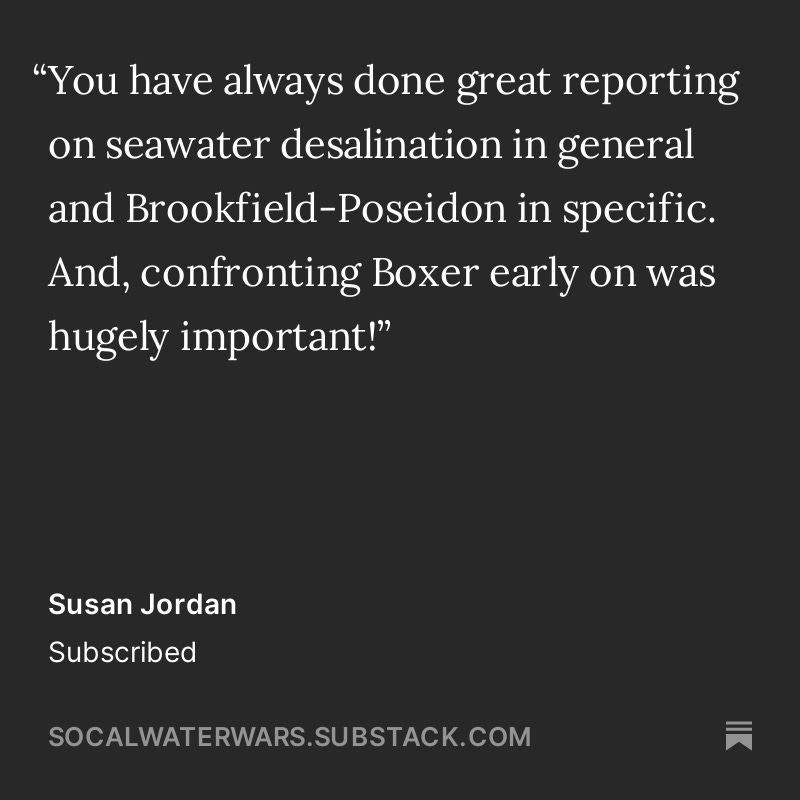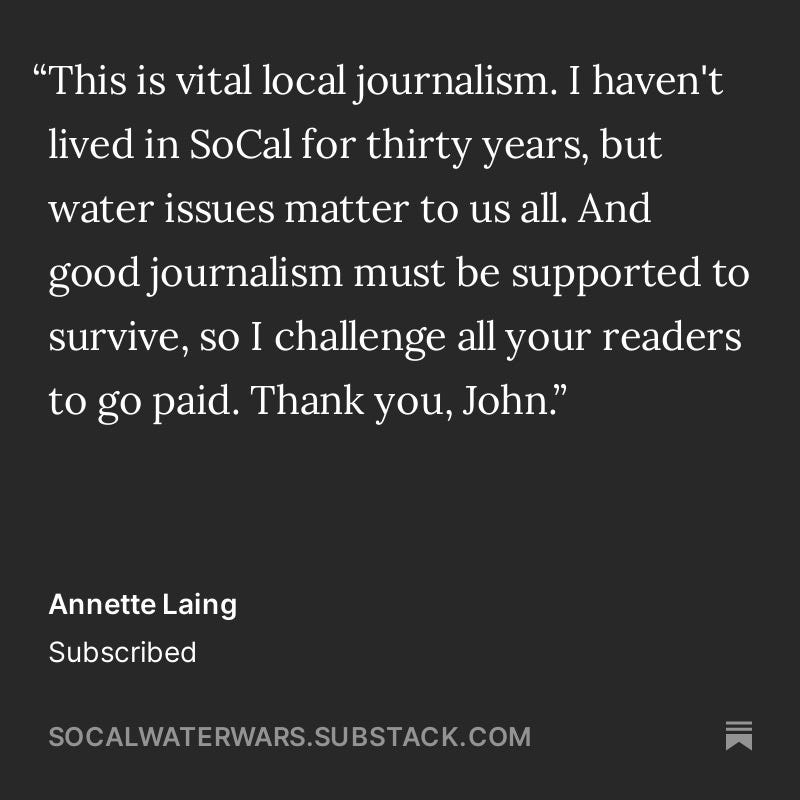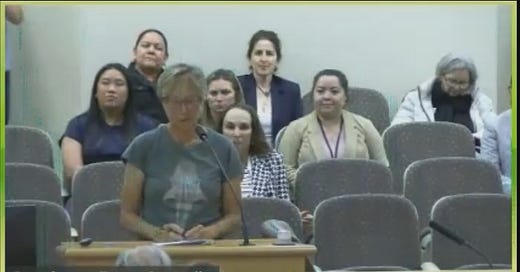Suzanne Till, former captain in the United States Marine Corps, with a Ph.D. in Water Resources Geography and a Masters in Geography and Urban Planning, was elected to the Board of Directors of the Padre Dam Municipal Water District in 2020, defeating the Division II incumbent with her campaign to keep water rates down.
Since then, she has been a tireless advocate for struggling ratepayers and against the meteoric rise in water rates imposed on local water districts by the San Diego County Water Authority (CWA), the water wholesaler for 23 districts countywide.
Those water agencies were told by CWA that they should expect a 39 percent rate increase over the next few years, 18 percent in the first year. That created a firestorm among their elected and appointed representatives who insisted on watering down the inevitable increase by “kicking the can down the road.”
The big leader of the firestorm was the City of San Diego, for whom much of the county’s water infrastructure was built and whose completion of a massive wastewater (Pure Water) treatment system will take additional sales revenue from CWA and raise its rates even more.
The CWA serves about 2.5 million people. It gets 52 percent of its water from the Colorado River through the Imperial Irrigation District (IID) at and 14 percent from the Metropolitan Water District of Southern California (MWD).
The MWD is the southlands largest water wholesaler, providing 19 million people with fully treated water at $1,256 per acre-foot.
IID’s water for San Diego County residents comes at about $1,200/AF, based on 2022 rates plus a $400-$500 “exchange rate” imposed by MWD. This supply is part of a take-or-pay contract with the IID that expires in 2047.

Ten percent of CWA’s water comes from the $1 billion Claude "Bud" Lewis Carlsbad [ocean] Desalination Plant, owned by Channelside, which can produce up to 48,000/AF of potable desalinated ocean water annually.
CWA is bound by a 30-year take-or-pay contract to buy the plant’s water for up to the full production amount during that period regardless of need.
The current cost, according to a CWA bulletin posted last January, is $3,400/AF, almost three times the cost of MWD or IID water and about $300 more than the agency estimated in 2022.
That would be $163,200,000 for the entire year with full production. But the CWA has not revealed how much, if any, water the desal facility is currently producing during reconstruction of its seawater intake system to keep up with environmental regulations.
By 2026, according to CWA’s 2022 estimate, the cost of its desalinated water will be $3,809/AF; but taking into account past low estimates, it could easily become $4,000/AF.
Calculating 48,000/AF x $4,000, the amount spent by ratepayers on desal in 2026 will be $192,000,000.
That’s a lot of money for a water agency with $2 billion in debt and a $1.8 billion budget while on the verge of credit-rating downgrades.
In July, CWA directors settled on a budget that minimizes rate increases by “kicking the can down the road.”
At its July 25 meeting the CWA board voted to raise its rates for 2025 14 percent, not 18 percent, contingent on $2 million in operating cuts and holding back on $7 million scheduled for vital canal earthquake-retrofitting.
Some directors thought that was dangerous—but the majority of them thought it was more dangerous to piss off their ratepayers. Still, water rates will rise from $1,789/AF to $1,996/AF in 2025 for treated water.
The biggest single-cause of the rate increase is water from Channelside’s unneeded super-costly Carlsbad desalination plant. CWA blends that water with its cheaper imported Colorado River water and sells it to all of its customers, whether they want to pay for more expensive desal-water or not.
The effects of skyrocketing water rates passed along to local ratepayers vary with the amount of water each agency buys compared to how much they rely on cheaper local supplies instead.
Like the CWA, those agencies use “rate stabilization funds”, created by over budgeting for water supply needs in previous years, to offset rate increases for the short term.
Meanwhile, the Authority continues to overestimate future water demand and budget for lofty sales-projections as ratepayers conserve more.
A 2020 study conducted by 18 of its member agencies concluded it “is likely that long-term Water Authority demands are at significant risk of declining to below 330,000 AF/yr by a considerable margin.” Current projections assume a need for 444,000/AF of water supply annually (see graph above).
By the end of fiscal year 2024, according to a July 17 staff report, water sales dropped to “20 percent below budget with a projected net revenue loss of over $41 million.”
San Diego County ratepayers’ continued adaptation to frequent droughts and climate change by conserving water added to CWA’s current glut of expensive water derived from take-or-pay deals for water from desalination and IID.

The development of independently run local water supplies by some of CWA’s member agencies will exacerbate that “problem.”
Pure Water projects by the City of San Diego and Padre Dam Municipal Water District coming online in 2035 and 2026 respectively will further reduce CWA sales by up to 59,000/AF and 15,000/AF.
The Sweetwater Authority, which supplies water for 190,000 residents in Chula Vista, Bonita, and National City has its own reservoirs (Loveland and Sweetwater) and a small inland desalination plant used to clean brackish groundwater.
And the agency is mulling over adding a small wastewater-treatment facility to its water portfolio ten years from now.
All three water agencies are motivated by high costs to roll off if not detach from CWA.
At a recent local Democratic Party endorsement meeting, Jose Lopez, board president of Otay Water District and a candidate for re-election, recalled that his agency had voted against the Carlsbad desal plant “because we thought it was just too expensive, and we were proven right.”
Steve Castaneda, who serves on the Sweetwater board, chimed in. “We are working hand-in-hand with Otay to develop the kinds of local resources that will take us off of County Water,” he said. “We are buying a fraction of the water because it is triple what any of us want to pay.”
Rainbow Municipal Water District and Fallbrook Public Utility District, each serving large agricultural communities as well as residential, detached from CWA last year to avoid the Carlsbad connection. Both say they will save millions of dollars down the line despite heavy exit fees.
Director Till’s proposed solution
Suzanne Till presented the most unique rate stabilization proposal made so far to the CWA board at a June 27 budget hearing.
It’s called creative destruction, an evolutionary business process that depends heavily on free-market forces to improve economic efficiency by offsetting obsolete practices with innovative ones.
The topic is taught in universities to students of economic-geography, says Till, speaking as a fellow professor.
In an email exchange, Till quoted from a textbook, Human Geography by Paul Knox and Sallie Marston, 7th edition (2016), Pearson (publisher) to explain creative destruction.
Creative destruction involves the withdrawal of investments in activities (and regions) that yield low rate profits, in order to reinvest in new activities (and new regions).
“The most classic example of creative destruction,” she explained in an email, “is the movement from gasoline autos to electric autos. Companies chose to stop investment in one activity to move to a more profitable activity or product.”
“In simple terms,” she wrote, “stop doing what is NOT working, and try something new.”
It will take a lot more academic research on her part, she says, to figure out the details needed to apply the concept of creative destruction to SDCWA, but she already has some ideas in mind:
1) Creative destruction of an institution: Allow SDCWA to go bankrupt, and then start again. Maybe bankruptcy would allow the take or pay contracts to be renegotiated.
2) End all government subsidies to Poseidon. Do what it takes to end the contract with Poseidon. Do not even consider desalination as a water source, and move investment to water purification. That is what MWD is doing FYI.
Creative destruction seems like a more useful term than bankruptcy for allowing the SDCWA to step away from Channelside and perhaps avoid its full $1.3 billion obligation to the company for abandoning its contract.
That issue remains to be sorted out, but one thing is for sure, according to Till:
“San Diego County ratepayers cannot [continue to] bail out CWA’s business failures by paying double digit water rate increases year after year.”
Meanwhile, Padre Dam Municipal Water District hasn’t increased rates since at least 2020.







Share this post